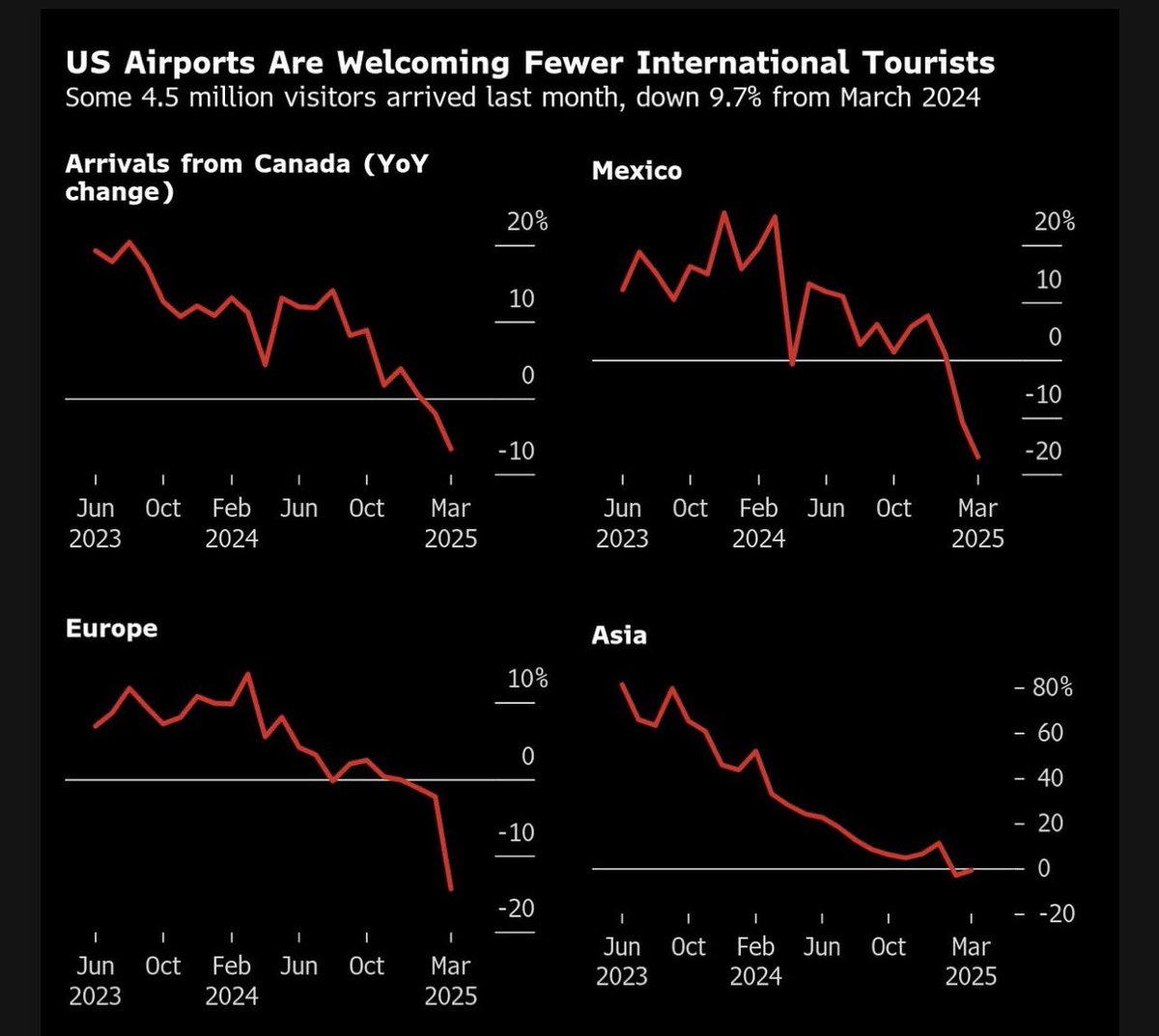
The Impact of Declining Foreign Tourism on the Domestic Travel Industry
In recent times, the foreign tourism sector has seen a dramatic decline, which has significant implications for the U.S. travel industry. According to recent insights shared by Spencer Hakimian on Twitter, foreign tourism has "fallen off a cliff," leading to a staggering impact on an industry that contributes approximately $100 billion to the economy. This summary aims to delve into the ramifications of this downturn, highlighting the sectors most affected and the regions primarily concentrated in tourism.
Understanding the Domestic Tourism Landscape
The domestic travel industry in the United States is multi-faceted, encompassing a wide range of services including hotels, airlines, restaurants, and tour guides. This industry is particularly concentrated in key regions such as New York City, southern Florida, southern California, and Las Vegas. Each of these areas thrives on tourism, attracting millions of visitors each year who contribute significantly to local economies.
Key Regions Affected by the Decline
- New York City: As one of the most visited cities in the world, NYC relies heavily on tourism. The decline in foreign visitors has led to decreased occupancy rates in hotels and a drop in patronage for restaurants and attractions that thrive on international tourists.
- Southern Florida: Known for its beaches and vibrant nightlife, southern Florida has also felt the sting of reduced foreign tourism. Many local businesses that cater to international guests, including tour guides and hospitality services, are reporting significant losses.
- Southern California: With attractions like Disneyland and Hollywood, southern California is another region that heavily depends on tourist dollars. The drop in foreign visitors has led to a downturn in the local economy, affecting jobs and revenue streams in the hospitality sector.
- Las Vegas: The entertainment capital of the world, Las Vegas, is particularly vulnerable to changes in tourism dynamics. The city’s economy is intricately linked to the influx of visitors, and the absence of foreign tourists has created a noticeable impact on its vibrant hospitality and entertainment scene.
The Ripple Effect on Related Industries
The decline in foreign tourism is not just a challenge for hotels and airlines; it has a ripple effect throughout various interconnected industries. Restaurants, tour guides, and entertainment venues are experiencing the consequences.
- YOU MAY ALSO LIKE TO WATCH THIS TRENDING STORY ON YOUTUBE. Waverly Hills Hospital's Horror Story: The Most Haunted Room 502
Hotels and Lodging
Hotels are facing increased vacancy rates as fewer international tourists choose to visit the U.S. This situation forces many establishments to lower their prices, which can lead to decreased revenue. Additionally, the hospitality staff is often reduced, leading to job losses and economic instability in local markets.
Airlines
Airlines are also feeling the pinch. With fewer international travelers, flight routes may be altered or canceled, leading to a reduction in available flights and further impacting the ability of domestic travelers to reach their destinations. This decline may result in a series of challenges, including increased ticket prices due to decreased availability.
Restaurants and Dining
Restaurants that relied on the vibrant international dining scene are facing challenges as well. With fewer tourists to fill tables, many establishments are struggling to stay afloat. This downturn not only affects the business owners but also has implications for the staff employed in these venues.
Tour Guides and Local Attractions
Tour guides who provide insights into local culture and attractions are seeing a significant drop in bookings. With fewer tourists, many guides are finding it difficult to secure enough work to sustain their livelihoods. Additionally, local attractions that depend on foot traffic from international visitors are also feeling the pressure.
Adapting to the New Norm
In light of the challenges posed by declining foreign tourism, the domestic industry must adapt to the changing landscape. This adaptation may include focusing on strengthening domestic tourism, creating packages aimed at local travelers, and enhancing marketing efforts to attract visitors from within the country.
Strategies for Recovery
- Boosting Domestic Travel: With international travel uncertain, promoting local travel experiences can help mitigate the impact. Marketing campaigns that highlight the beauty and experiences available within the country can encourage residents to explore their own backyards.
- Innovating Hospitality Services: Hotels and restaurants can consider offering unique experiences that appeal to local visitors, such as themed events, staycation packages, or exclusive dining experiences.
- Leveraging Technology: Embracing technology can help businesses reach a broader audience. Utilizing social media and digital marketing can enhance visibility and attract new customers.
- Building Partnerships: Collaborating with local businesses can create synergistic opportunities that attract more visitors. For instance, partnering between hotels and local attractions can offer bundled services that provide greater value to tourists.
Conclusion
The decline in foreign tourism poses significant challenges to the U.S. domestic travel industry, particularly affecting key regions like New York City, southern Florida, southern California, and Las Vegas. Affected sectors, including hotels, airlines, restaurants, and tour guides, are already feeling the impact of this downturn. However, by adapting to the new landscape and focusing on boosting domestic travel and innovative strategies, the industry can work toward recovery.
In essence, while the current state of foreign tourism presents challenges, it also offers an opportunity for local businesses to reinvent themselves and cater to the evolving needs of travelers. The future of the domestic travel industry may depend on how effectively these businesses respond to the changes and capitalize on new opportunities to engage with local and domestic audiences.

Foreign tourism has fallen off a cliff.
This is a $100B domestic industry largely concentrated in NYC, southern Florida, southern California, and Las Vegas.
Hotels, airlines, restaurants, and tour guides are already feeling the pain. pic.twitter.com/rbfvYZzxhy
— Spencer Hakimian (@SpencerHakimian) April 15, 2025
Foreign Tourism Has Fallen Off a Cliff
Let’s face it—foreign tourism has taken a serious nosedive. A staggering $100 billion domestic industry is at stake, and the impact is being felt far and wide. Major tourist hotspots like NYC, southern Florida, southern California, and Las Vegas, which are usually bustling with international visitors, are now eerily quiet. This situation has left hotels, airlines, restaurants, and tour guides grappling with the harsh reality of declining business.
This Is a $100B Domestic Industry Largely Concentrated in NYC, Southern Florida, Southern California, and Las Vegas
When we talk about a $100 billion domestic industry, it’s hard to underestimate its importance. Cities like New York, Miami, Los Angeles, and Las Vegas rely heavily on foreign tourism to support their economies. These cities are not just popular for their attractions; they’re also known for their vibrant cultures, diverse food scenes, and unique experiences that draw millions of visitors each year. However, the recent downturn means that many of these cities are feeling the strain.
In NYC, iconic landmarks like the Statue of Liberty and Times Square are now seeing fewer tourists. Southern Florida, famous for its sun-soaked beaches and lively nightlife, is also feeling the pinch. In southern California, attractions like Disneyland and Hollywood are not receiving the foot traffic they used to. And Las Vegas, often dubbed the Entertainment Capital of the World, is witnessing near-empty casinos and shows.
Hotels, Airlines, Restaurants, and Tour Guides Are Already Feeling the Pain
As foreign tourism dwindles, the ripple effects are undeniable. Hotels that once thrived on international guests are experiencing significant drops in bookings. Many have had to lay off staff or even close their doors temporarily, which is heartbreaking given the personal stories and lives intertwined with these establishments. The same goes for airlines. With fewer travelers flying in and out, many airlines are facing financial difficulties. For instance, some have had to cancel routes, which only further complicates the travel landscape.
Restaurants, too, are feeling the crunch. Many establishments that catered specifically to tourists are struggling to keep their doors open as foot traffic disappears. It’s not just about the loss of revenue; it’s about the loss of jobs and livelihoods that come with it. Tour guides, who thrive on sharing their knowledge and passion for their cities, are also facing the harsh reality that the tourist season is dwindling. They often rely on tips from visitors, and with fewer people around, their income has significantly dropped.
Why Is Foreign Tourism Declining?
The reasons behind the decline in foreign tourism are multifaceted. One significant factor is the ongoing repercussions of global events, including health crises and geopolitical tensions. Many countries have imposed travel restrictions that make it difficult for international tourists to visit the U.S.
Additionally, economic uncertainties play a role. With inflation affecting many countries, potential travelers may think twice before spending on international vacations. Even if they want to visit those iconic American destinations, the financial burden might deter them from making the trip.
The Impact on Local Economies
The decline in foreign tourism is not just a problem for the hospitality industry; it has broader implications for local economies. When tourists visit, they not only spend money on hotels and flights but also on local attractions, shopping, and dining. This influx of cash supports countless jobs in various sectors, from retail to entertainment.
Take Las Vegas, for example. The city thrives on tourism, with its economy heavily reliant on the influx of visitors. The hotels, casinos, and restaurants contribute to billions in revenue, and as tourism declines, so does the city’s economic vitality. Local businesses that rely on tourist spending are facing hard times, with many struggling to survive without that essential income.
What Can Be Done to Revive Foreign Tourism?
So, what can be done to turn things around? First and foremost, clear communication and collaboration between governments and the travel industry are crucial. Initiatives to ease travel restrictions and promote safe tourism can help encourage international visitors to return.
Marketing plays a vital role as well. Destinations can harness social media platforms to showcase their attractions and experiences, targeting potential travelers with engaging content that sparks their interest. A fresh approach, focusing on safety, cultural experiences, and unique offerings, could capture the attention of those considering a trip.
Reimagining the Tourism Experience
As we look toward the future, it may also be time to rethink the tourism experience altogether. With the rise of remote work, there’s an opportunity to attract longer-staying visitors who want to combine work and play. Cities could promote themselves as ideal locations for “workcations,” where people can enjoy a change of scenery while still being productive.
Additionally, focusing on sustainable tourism can also appeal to a growing demographic of environmentally conscious travelers. Highlighting eco-friendly practices and local experiences can enhance a destination’s appeal and attract a new wave of tourists.
The Road Ahead for the Tourism Industry
While the current state of foreign tourism is challenging, it’s important to remain hopeful. The industry has proven resilient in the past, bouncing back from various crises. With the right strategies, collaboration, and a focus on innovation, there’s potential for recovery.
As hotels, airlines, restaurants, and tour guides adapt to this new landscape, they can leverage the lessons learned during this period to create a more robust and appealing tourism industry in the future. By focusing on the unique aspects of their offerings and promoting a safe, welcoming environment, they can entice travelers back to the U.S. once more.
A Call to Action
As we ponder the future of foreign tourism, it’s essential for everyone to get involved. Support your local businesses, share your travel experiences, and promote safe travel practices. Every little action counts and helps to pave the way for a brighter future for the tourism industry.
In the end, while foreign tourism has indeed fallen off a cliff, there’s still hope on the horizon. With collective efforts, we can work towards a vibrant tourism landscape once again, welcoming travelers from around the world to experience the incredible offerings of the United States.
